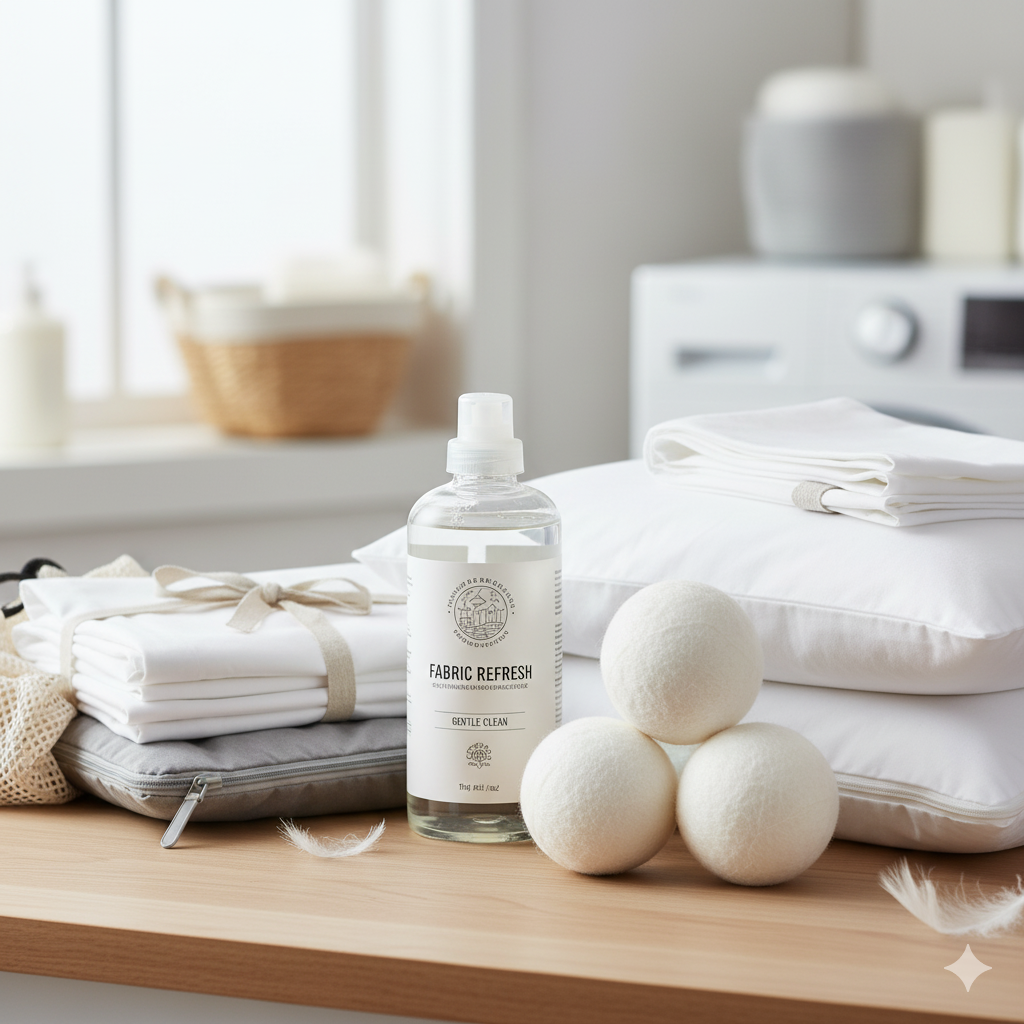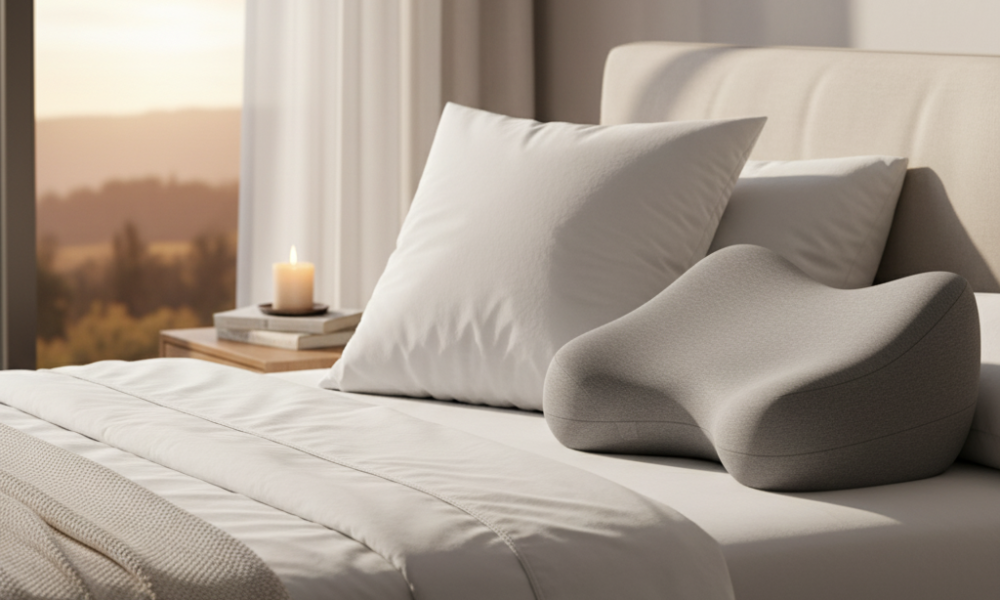Down vs. Memory Foam Pillows: The Ultimate Showdown
If you’ve ever found yourself standing in a bedding aisle wondering whether a down vs memory foam pillow will finally fix your neck pain, you’re not alone.
One feels like a soft hug; the other supports you like it was made just for your neck. This guide breaks down every difference — comfort, breathability, and maintenance — so you can choose the pillow that feels made for you.
What Is a Down Pillow vs. a Memory Foam Pillow?
Quick answer: Down pillows are filled with airy clusters from goose or duck down that feel cloud-soft, while memory foam pillows use viscoelastic foam that contours to your head and neck for precise support.
Key takeaways:
- A down vs memory foam pillow choice is softness (down) versus structure (foam).
- Down = plush loft, lightweight feel, and natural breathability.
- Memory foam = firm contouring and consistent neck alignment.
- Each type comes in multiple firmnesses, lofts, and price points.
Down gives you that luxury “hotel bed” feeling — the kind that gently molds to your head. Memory foam feels more personalized, adapting to your shape for steady support all night. One’s airy and romantic; the other’s engineered and dependable.
 Down fill (left) offers natural loft; memory foam (right) sculpts to your neck’s curve.
Down fill (left) offers natural loft; memory foam (right) sculpts to your neck’s curve.Support, Feel & Responsiveness
Quick answer: Memory foam delivers consistent alignment for side and back sleepers; down gives a soft, adaptive cradle that moves with you through the night.
Key takeaways:
- Memory foam = precise contouring, great for neck and shoulder relief.
- Down = plush give, ideal for stomach or combination sleepers.
- Foam holds its shape; down needs periodic fluffing to restore loft.
- Choosing a down vs memory foam pillow often comes down to alignment vs. plushness.
If you’ve ever woken up with stiff shoulders, foam’s structured contour may be your hero. It keeps your neck level with your spine, reducing strain and pressure points. Down, meanwhile, has that “ahh” factor — airy, responsive, and incredibly comfortable if you like to move freely in your sleep.
Want broader tips while you decide? See our guide to choosing pillows for comfort for shape, loft, and fill pointers across brands.
Breathability, Temperature & Allergen Potential
Quick answer: Down stays cool thanks to natural airflow, while memory foam retains more heat unless engineered with ventilation, open-cell design, or gel infusions.
Key takeaways:
- Down = naturally breathable, moisture-balancing, and airy.
- Foam = warmer; look for cooling gels, perforations, or open-cell foam.
- Down can harbor allergens if not well cared for; many foams are hypoallergenic.
- Hot sleepers often prefer down in the down vs memory foam pillow debate.
Hot sleeper? You’ll likely lean toward down. It allows airflow between clusters and tends to feel drier overnight. Memory foam’s density traps warmth, though modern cooling tech significantly narrows the gap. Down-alternative (poly) fills can be a middle ground if you avoid animal products but still crave breathability.
For whole-bed cooling strategies, explore our guides to temperature-regulating bedding and best bedding materials for hot sleepers.
Durability, Maintenance & Cost
Quick answer: Memory foam typically lasts longer with less work; down offers unmatched softness but needs fluffing and careful washing/drying to keep it perfect.
Key takeaways:
- Memory foam: often 3–5 years of consistent support with low maintenance.
- Down: can last up to ~10 years with gentle care and full drying.
- Use pillow protectors to reduce oils, sweat, and dust infiltration.
- Care routines may decide the down vs memory foam pillow winner for you.
If you’re not one for frequent fluffing, foam’s your friend. It holds form and usually needs only a washable cover and occasional spot cleaning. Down rewards attentive care — mild detergent, low heat, and extra time (or clean tennis balls) in the dryer to restore loft. Want an extra layer of defense for freshness? See our mattress protector guide for what to look for in breathable, easy-care protectors.
Prefer natural materials in the rest of your sleep setup? Check out organic bedding benefits to round out a breathable, eco-conscious bed.
 Keep your pillow fresh: use protectors, wash carefully, and dry fully for lasting loft.
Keep your pillow fresh: use protectors, wash carefully, and dry fully for lasting loft.Who Should Choose Down vs. Memory Foam?
Quick answer: Choose down if you love hotel-style softness; choose foam if you want dependable, ergonomic support for your neck and shoulders.
Key takeaways:
- Down = plush comfort for stomach and combination sleepers.
- Foam = structured support for side and back sleepers.
- Allergies and warmth sensitivity can tip the balance.
- Layering both can deliver a hybrid down vs memory foam pillow feel.
If you like sinking into a cool, breathable cushion, go down. If you crave that “supported yet soft” feel where your head stays perfectly level, go foam. Some sleepers even layer them — a foam core topped with a down or down-alternative cover for the best of both worlds.
Decision Checklist & Care Tips
Quick answer: Match your pillow to how you sleep, how you feel about upkeep, and how hot or cool you tend to run at night.
Key takeaways:
- Feel: Soft & airy (Down) vs. firm & contouring (Foam).
- Care: Down = regular fluffing; Foam = cover + spot clean.
- Allergies: Hypoallergenic down or foam options exist.
- Temperature: Down sleeps cooler; foam sleeps warmer.
- Replacement: Expect 2–5 years depending on quality and care.
- Use this to finalize your down vs memory foam pillow choice.
 Not sure where to start? Use this quick checklist to narrow your perfect match.
Not sure where to start? Use this quick checklist to narrow your perfect match.FAQ
- Are down pillows better than memory foam?
- Neither is universally “better.” Down is softer and more breathable; memory foam provides structured support. Your sleep position and temperature sensitivity should guide the choice.
- Can memory foam pillows cause neck pain?
- Only if the loft or firmness is mismatched. Side sleepers often need a higher-loft contour pillow; back sleepers a medium loft; stomach sleepers the lowest loft or a soft down option.
- Do down pillows go flat?
- They compress with use but can be revived by daily fluffing and thorough drying after washing to restore loft.
- Which pillow lasts longer?
- Quality memory foam usually offers 3–5 years of consistent support; well-cared-for down can last longer, though it requires more maintenance.
- Is there a hypoallergenic option for down?
- Yes. Look for “hypoallergenic” down that’s been washed to remove common irritants, or choose down-alternative or most memory foams, which are typically hypoallergenic.
Final Thoughts
At the end of the day, your pillow should feel like an exhale. If you crave that soft, cloudlike hug, go for down. If you prefer a pillow that has your back — and your neck — choose memory foam. Either way, the right choice makes every night feel like a deep sigh of relief. Explore more expert sleep guides at Cozy Bed Quarters.
Here’s to softer nights, cooler dreams, and waking up exactly how you like — refreshed.























